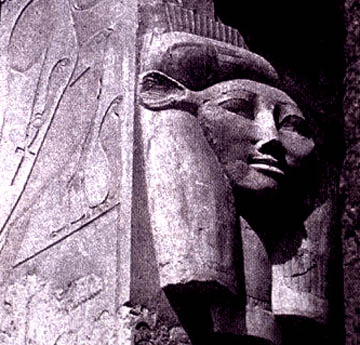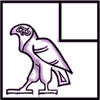THE HATHOR HOME PAGE
Dedicated to the Egyptian Goddess Hat-hor

|
Hathor
In earlier periods she was most often depicted as a full cow with the sundisk between her horns or as a slender woman wearing the horns-and-a-sundisk headdress (which may or may not have a uraeus upon it). She was also shown as a hippopotamus, a falcon, a cobra, or a lioness, however these were not as frequent as the woman or the cow. While there are some depictions of Hathor as a woman with a cow's head, this is mainly found only in the later periods. Hathor's symbology included such items as sistra (a type of rattle), the horns-and-sundisk headdress (in much later times incorporated into the attire of Isis), the menat (a type of ritual necklace that may have been used for percussive music), and mirrors. Many ancient mirrors and sistra decorated with smiling, often nude Hathors on them have been uncovered over the years, and Hathor's visage (with cow ears) commonly appeared at the top of stone columns in Egyptian temples, many of which can still be seen today. Her cult flourished in Ta-Netjer ("Land of God" -- modern day Dendera) in Upper Egypt and her priests included both men and women, many of whom were dancers, singers, or musicians as the arts fell under Hathor's domain. Priests of Hathor were also oracles and midwives, and people could go to some temples of Hathor to have their dreams interpreted by her priests. Hathor's protection was invoked over children and pregnant women. Hathor, as the Eye of Ra, "becomes" Sakhmet in the story "The Destruction of Mankind". Engraved into one of the shrines of Tutankhamen's tomb, the story tells how Hathor, at the request of her father (Ra), turns into Sakhmet in order to punish humans for transgressing against him. When she nearly wipes out all of humanity, Ra tries to stop her and, failing in that, contrives to get her drunk, whereupon she immediately forgets what it was she was doing and goes back to being Hathor. Hathor also appears as a minor character in "The Contendings of Horus and Seth". Her father (Ra) falls into a black mood so Hathor sets forth to cheer him up. Removing her clothing, she dances around his throne until he smiles again. An additional myth, sometimes called "The Distant Goddess", tells of how Hathor became angry with Ra and wandered away from Egypt. Great sadness falls over the land and Ra, lost without his Eye, decides to fetch her back. However, Hathor has now become a deadly wild cat who destroys all that approaches her, and so no man or god will volunteer to go get her. Thoth eventually agrees to lure her back and, dressed in disguise, manages to coax the angry goddess to return to Egypt by telling her stories. Back in her homeland, she bathes in the Nile and once again settles into her normally gentle demeanor, but not before the waters turn red from the effort of cooling her rage. In some versions of this story it is Tefnut, not Hathor, who wanders away from Egypt, and Shu, not Thoth, who brings her back. Hathor is associated with numerous other Egyptian goddesses. Her connections with Bastet helped to "soften up" that deity's visage, and as discussed previously Hathor was the other side of the Sakhmet coin. Hathor also seems to have absorbed many of the properties of Bat (another pre-Dynastic cow goddess), who is depicted at the top of the famous Narmer palette overseeing the events detailed therein. Hathor is also known as the "Lady to the Limit" ("limit" meaning the edges of the known universe) and the "Lady of the West"; her image is sometimes seen on funerary depiction as she stands behind Osiris, welcoming the dead to their new home. Other titles of Hathor include the "Divine (or Celestial) Cow", "Mistress of Heaven", and "Lady of Gold," the last two of which were sometimes attributed to the queens of ancient Egypt. Hathor was also known as the "Lady of Greenstone and Malachite" due to her being regarded as a goddess of the desert fringes where such mines existed. The Greeks called Hathor by the name of their goddess, Aphrodite. In the very late stages of Egyptian religion (over two millennia after Hathor had first appeared) she became almost totally absorbed into Isis (who acquired, aside from Hathor's headdress, the sistrum as well), resulting in frequent mistaken identity between the two. There are, however, subtle differences. When Isis is shown with the horns she is also (usually) shown with either the vulture headdress (which was associated with Mut, a goddess of Thebes), winged, or wearing a multi-colored feathered dress. There are of course exceptions (such as in the tomb of Horemheb), in which case knowledge of hieroglyphs is necessary to discern which goddess is which. At the temple of Nefertari at Abu Simbel, Nefertari is shown as Hathor in many places, and Ramses II (the husband of Nefertari) is shown in one sanctuary receiving milk from Hathor the cow. When a child was born in Egypt, seven Hathors (somewhat like European fairy godmothers) would appear to "speak with one mouth" and determine the child's fate. Hathor's own child was Ihy, who was worshipped in Dendera with her and Horus-Behdety. Like his mother, Ihy was a god of music and dancing, and was always depicted as a child bearing a sistrum.
Origins of Hathor Soped-hotep and the Cat Hathor, the Divine Flasher Hathor, Mistress of the Sistrum (under constr.) The Hathor-Byblos Connection Hathor, Sycamores, and the Sinai. Hathor's Horns, the Golden Calf, and Moses The Mirrors of the Israelite Women (under constr.) The Levites' Incense Burners (under constr.) Hathor and the Mines of Timna Zipporah, the Priest's daughter (under constr.) Tharbis, Adoniah, and Aten-it (under constr.) Hathor in Southern Palestine Cozbi, the Last Priestess (under constr.) |
return to top of page
The Sistrum in the Sinai | Dale R. Broadhurst Home Page
last updated: Feb. 1, 2006
